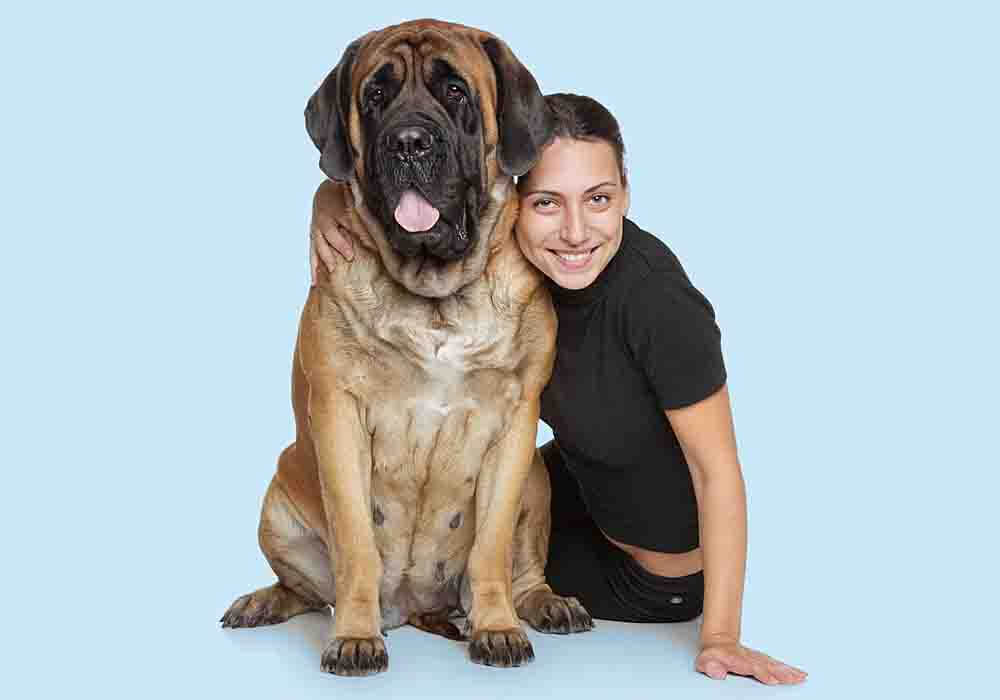English Mastiff 101
Top 25 Common Questions Answered
by Ken Alden
For new English Mastiff owners, caring for such an enormous dog is a daunting task. Despite their guard dog tendencies and imposing appearance, Mastiffs are well-loved for being surprisingly gentle giants. We're breaking down the 25 most common questions asked by first-time owners.
English Mastiff 101 Basics...
English Mastiffs are excellent family dogs, and they’re very loyal protectors. This breed thrives in a wide range of environments and requires only light exercise and a small amount of space to be happy and comfortable. Their calm and laid-back temperament makes them agreeable and adaptable.
Keep reading if you want to learn more about the English Mastiff's temperament, care requirements, and more. By the end of this article, you'll know if this breed is the right choice for you and your household.
Pro-tip: Ever try lifting an English Mastiff? Their weight can hurt not only your back but their joints when they hop down from cars, sofas or even your bed. To protect your back and theirs check out the best Mastiff ramps on Amazon.com now.

Are English Mastiffs Cold Weather Dogs?
While they can handle cold weather, English Mastiffs generally prefer spending most of their time indoors by their owner's side. Frigid temperatures below 30 °F (-1.1 °C) or so are too cold for Mastiffs to withstand comfortably.
Here's more about how this breed handles cold and hot temperatures...
Are English Mastiffs Cuddly?
Don't be fooled by this breed's intimidating looks, as they’re highly affectionate and greatly enjoy cuddling up with their owners and just about anyone they've established a bond with.
Although it might take some time for your Mastiff to warm up to you enough to seek out cuddles and affection, once they do, you'll find that they’re very cuddly and sensitive dogs.
Are English Mastiffs Dangerous?
Your English Mastiff can undoubtedly be dangerous towards strangers, especially if you’ve trained them to be a guard dog for your home. However, they’re very loving and calm around their families when given proper socialization and training.
You can expect your Mastiff to be a fierce and loyal protector with a warm and gentle heart. However, they may be dangerous for babies and small children, as they can sometimes be unaware of their size and strength while playing.
Pro-tip: English Mastiff anxiety, aggression, destructive chewing, jumping up, fearfulness, and other behaviors can be controlled with the right training program.
Here’s a great course that
addresses these issues along with many other dog training basics: Check it out now!
Are English Mastiffs Friendly?
This English Mastiff's gentle giant nature makes them quite friendly and affectionate towards their family, though they are a bit distrusting and aloof towards strangers at first. However, once they warm up to someone, they’re incredibly lovable and become progressively more outgoing and playful over time.
Are English Mastiffs Good Apartment Dogs?
Thanks to their low-to-moderate energy level and calm temperament, English Mastiffs do surprisingly well in smaller homes and apartments.
If you plan on keeping your Mastiff in an apartment, however, be sure they get regular exercise in the form of short walks and light playtime daily to prevent them from becoming bored and eventually overweight.
Are English Mastiffs Good for First-Time Owners?
English Mastiffs are fine for first-time owners, provided they’re willing to do the necessary research beforehand. English Mastiffs are agreeable in temperament and have little grooming needs.
Additionally, they don't require much exercise to stay happy and healthy, making them quite suitable for new dog owners who can put up with this dog's massive size and excessive drooling.
Wondering If The English Mastiff
Is The Right Dog For You Or Your Family?
Then Check Out This Helpful YouTube Video...
Do English Mastiffs Like Water?
Mastiffs generally like water, although some individuals may be afraid of water at first because of their gentle and occasionally timid nature. Introduce your Mastiff to water slowly, and don't expect them to hop into your pool with no hesitation.
This preference can vary slightly from dog to dog, but overall, Mastiffs tend to enjoy swimming and being around water in general.
Pro-tip: English Mastiff's (and their owners) love dog crates…and for good reasons. Crates keep dogs from mischief while you're away, are perfect for house training, for traveling by car, and provide the dog a place to de-stress. Check out the best Mastiff crates on Amazon.com now.
Are English Mastiffs Good Swimmers?
The English Mastiff is a fairly strong swimmer, but as mentioned earlier, not all Mastiffs love water, at least at first. Depending on your dog's personality and temperament, they may take some time to get used to being in the water.
Are English Mastiffs Lazy?
English Mastiffs have a relatively low energy level and can be quite lazy, preferring to take long naps around the house most days. To keep your Mastiff healthy and in good physical shape, you'll need to take them on short walks daily.
However, be careful not to overexert your Mastiff, particularly in very hot weather, as they can overheat quickly due to their large size and heavily wrinkled faces.
Can an English Mastiff Be a Service Dog?
English Mastiffs aren't necessarily the best breed suited for this purpose, but they certainly can be great service dogs with lots of diligent training and persistence. They also make excellent therapy and emotional support dogs thanks to their gentle, patient, and calm personalities. english mastiff 101
Can English Mastiffs Be Left Alone?
While they can be left alone for a few hours at a time, English Mastiffs are prone to separation anxiety. That’s because they develop close bonds with their owners and are quite emotionally sensitive. Try to avoid leaving your Mastiff alone for more than six hours or so, and don’t leave puppies alone for any amount of time.
Can English Mastiffs Hike?
Short, low-intensity hikes are a great form of exercise for your English Mastiff, but be careful in hot weather. The breed is susceptible to overheating. Also, avoid long or strenuous hikes, as they can put too much stress on your Mastiff's sensitive bones and joints.
Do English Mastiffs Drool?
It’s essential to have a cleaning rag nearby at all times to clean the drool off of your Mastiff's face, as they drool excessively and constantly. Mastiffs drool more than most breeds due to their floppy, drooping lips that can't keep saliva in their mouths very well.
Do English Mastiffs Have an Undercoat?
English Mastiffs have two coats: a short, waterproof outer layer and a shorter, denser undercoat. Both layers shed quite heavily and require regular grooming.
Do English Mastiffs Have Sensitive Stomachs?
Overall, English Mastiffs aren’t very picky eaters and typically don't have overly sensitive stomachs. However, this can vary from dog to dog, depending on their preferences and existing health issues.
As long as your dog is healthy and its diet has plenty of protein and fiber to support its large size, you probably won't have any issues with food sensitivity.
Do English Mastiffs Have Webbed Feet?
Most Mastiffs have webbed toes, which helps them greatly in their ability to swim. The size and shape of the webbing vary from dog to dog, however. And not all Mastiffs will enjoy a trip to the lake or a hop into the pool.
Do English Mastiffs Like Snow?
While they don't tolerate extreme cold very well, English Mastiffs generally enjoy playing in the snow for short periods. Taking your Mastiff for a brief walk or play in the snow is a great form of exercise for them.
Do English Mastiffs Smell Bad?
Aside from the usual dog smell, English Mastiffs usually don't smell particularly bad as long as they get regular baths every week or so. English Mastiffs are also prone to mild gassiness from time to time.
If your Mastiff is unusually smelly, a skin infection or other health issue could be the cause.
How Big Do English Mastiffs Get?
English Mastiffs are enormous dogs, with males being significantly larger and taller than females. Even before they reach full size their growth rates are amazing.
Male Mastiffs can reach anywhere from 170 to 250 pounds (77.11 to 113.39 kgs) and around 30 to 33 inches (76.2 to 83.82 cm) in height.
Female Mastiffs grow to a maximum size of about 130 to 200 pounds (58.96 to 90.71 kgs) and 25 to 30 inches (63.5 to 76.2 cm) in height.
How Fast Can English Mastiffs Run?
The English Mastiff isn’t well-suited to running very fast or for long periods because of its large size and muscular build. Mastiffs, in general, are on the slower side compared to more slender and agile breeds like greyhounds and whippets. English Mastiff 101
How Long Do English Mastiffs Live For?
The average lifespan of an English Mastiff is roughly 8 to 10 years, with some living slightly longer depending on genetics and the quality of care they receive. You can extend your Mastiff's lifespan by getting yearly vet checkups and addressing any health issues as quickly as possible.
Do English Mastiffs Like Cats?
Generally, English Mastiffs get along well with cats because of their laid-back and gentle temperaments. Early and diligent socialization is key to getting your Mastiff to get along with any cats in your home.
How Long Do English Mastiffs Stay in Heat?
For English Mastiffs, heat cycles last around two to four weeks, or approximately 14 to 28 days at a time. However, a Mastiff’s heat cycle length depends on a few factors, such as the dog’s genetics and age.
At What Age Can You Breed English Mastiffs?
It’s highly recommended to wait until your female Mastiff is at least 1½ years old, or 18 to 22 months of age, before you begin breeding her. Males are ready for breeding slightly earlier, at around one year or 12 to 15 months old.
When Do English Mastiffs Reach Full Height?
Even though they reach sexual maturity within their first two years, English Mastiffs tend to grow slowly compared to other well-known dog breeds. Most Mastiffs won’t reach their full size until they’re about three years old.
English Mastiff 101...Final Thoughts
English Mastiffs are generally very mellow and friendly, yet they’ll protect their owners fiercely when necessary. They’re highly intelligent and trainable and do well in a variety of households.
The English Mastiff makes an incredibly loyal and dedicated companion, provided you can handle their large size and frequent drooling and shedding.
Return to the top of this English Mastiff 101 page

About the Author...
Ken Alden, a dedicated Mastiff owner for over eight years, is acclaimed for his expertise in care, grooming, and training. Read more About Me and my dog Shadow.
- Mastiff Guide Home ›
- English Mastiffs Dog Info ›
- English Mastiff 101






